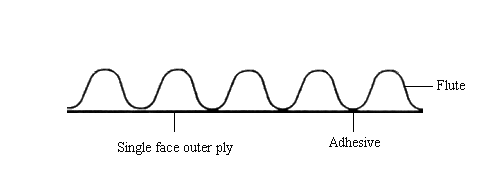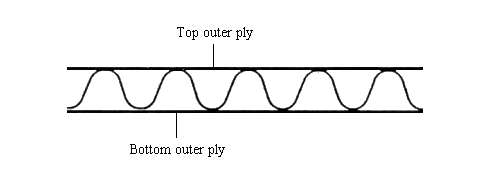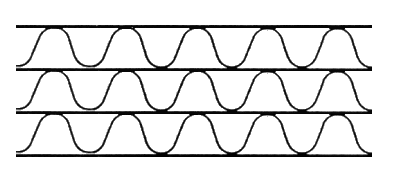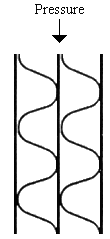Corrugated board consists of one or two outer plies, the flutes and, in multi-ply types of corrugated board, of one or more intermediate plies. Corrugated board is classified as follows according to the number of outer/intermediate plies and flutes:
 |
| Figure 1: Single face corrugated board consists of one ply of fluted paper, onto which paper or cardboard is glued. |
 |
| Figure 2: Single wall (double face) corrugated board consists of one ply of fluted paper which is glued between two plies of paper or cardboard. |
 |
| Figure 3: Double wall corrugated board consists of two plies of fluted paper which are glued together by one ply of unfluted paper or cardboard and the exposed outer surfaces of which are each covered with one ply of paper or cardboard. |
 |
| Figure 4: Tri-wall corrugated board consists of three plies of fluted paper which are glued together by two plies of paper or cardboard and the outer surfaces of which are likewise each covered with one ply of paper or cardboard. |
As is clear from the structure of the various types of corrugated board, they differ most with regard to strength, which increases with the number of plies and/or the quality of the paper used. The strength of corrugated board is determined by the following three characteristics:
 |
Bursting strength [kPa] |
 |
Puncture resistance [J] |
 |
Edgewise crush resistance [kN/m] |
The strengths are divided into classes which are defined in DIN standard 55468.
Cartons are usually made from double wall and single wall corrugated board. Cartons made from high strength corrugated board, generally tri-wall (or ultra-heavy) corrugated board, are used for transport operations involving severe climatic conditions and mechanical stresses and for those involving heavier cargoes. Moreover, corrugated board made with moisture-resistant glue and wet strength paper is used in particular for maritime transport. Wet strength grades of corrugated board are marked with the following quality stamp:
 |
Figure 5 |
(Click to enlarge) |
When making cartons, it is vital for the flutes in the end and side walls to be arranged upright so that they can withstand the greatest possible pressure when stacked. In contrast, if the flutes are horizontal, they have very poor rigidity and can be crushed very easily (see Figure 6).
 |
Figure 6: When arranged in this way, the flutes would collapse when exposed to pressure from above. Carton strength is then compromised and entire stacks may collapse. |






